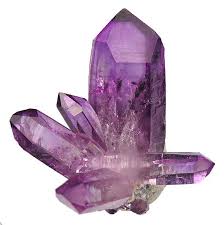Amethyst was once a stone of royalty worn in crowns and around the necks of nobility, bearing a price tag that rivaled ruby and emeralds. The stone is included in royal collections all over the world, from ancient Egypt to the British crown jewels. Historically, the stone was believed to assist prophecy and visions and to bring riches and powers to its owners. It has always been associated with the civil and religious classes that have ruled human cultures.

Pictured: Josephine’s Amethyst Tiara
This tiara dates back to the Napoleonic times. The necklace (as it was in original form) is part of a larger amethyst demi-parure which is owned by the Swedish royal family.
So what changed? During the 19th Century, large deposits of amethysts were discovered in Brazil, making it more abundant. As its rarity decreased, so did its price. Today, amethysts are known as a semi-precious gemstone and even fine amethyst has a modest price tag. Large gems remain affordable as price per carat does not rise dramatically with larger size. They are the most valued quartz variety and its purple to pastel hues retain wide consumer appeal.




